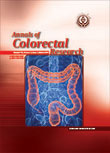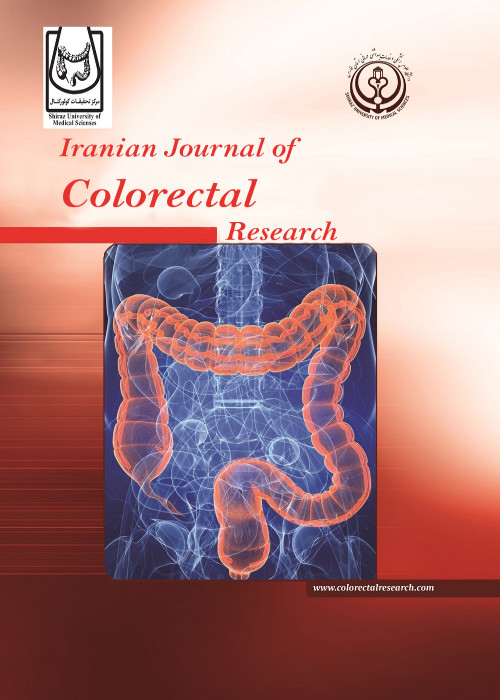فهرست مطالب

Iranian Journal of Colorectal Research
Volume:5 Issue: 1, Mar 2017
- تاریخ انتشار: 1396/02/21
- تعداد عناوین: 6
-
-
Page 1BackgroundExpanding over Crohns disease in the Far East, and easily biased to chronicity, ulcerative colitis (UC) continues to pose a challenge. Traditional remedies have been based on control of inflammation and immune suppression, effected by such classic drugs as mesalamines, corticosteroids, and thiopurines. However, these molecules have long proven unable to fully control the disease or modify disease history, leaving an alternative fully desirable.ObjectivesIn this study, we aimed at highlighting the indications for biological therapy in UC.MethodsLiterature review.ResultsRecently, it has been demonstrated that the proinflammatory cytokine tumor necrosis factor (TNF) plays a significant role in UC, opening a way for anti-TNF biologics to join the therapeutic arsenal. These monoclonal antibodies, now available as hybrids or fully human preparations, are able to attain at least 50% response rate of refractory UC. However, primary non-response amounts to 20% - 40%, and loss of response to 40%. Optimization protocols allow for biologic molecule switching (disease symptoms, antibody positive) or replacement with another drug class (symptoms but no antibodies). Infectious/neoplastic /autoimmune toxicities together with high costs continue to be a problem (52%).ConclusionsThese results warrant further therapeutic leaps forward: personalized therapy plans based on the patiens genetic profile, and pre-emptive measures based on peoples education to modify diet and life habits.Keywords: Inflammatory Bowel Disease, Biologics, Immune Suppression
-
Page 2BackgroundPerianal abscesses remain one of the most frequent surgical cases encountered by both general and colorectal surgeons. The use of broad-spectrum empirical antibiotics for perianal abscesses after drainage also remains common, although with questionable benefit.ObjectivesThe aim of the study conducted was to evaluate the role and efficacy of intra- and post-operative empirical antibiotic combination with a wide antibacterial spectrum for the treatment of perianal abscess and fistula-in-ano.MethodsAn observational longitudinal study consisted of 150 patients; 50% of them underwent incision and drainage of their perianal abscess. The rest had fistula-in-ano and were treated with fistulotomy. Patients were prescribed a course of empiric antibiotics at the time of diagnosis. The prescribed antibiotic consisted of two regimes. The mechanism of the first regime was based on inhibiting bacterial cell wall synthesis, whereas the second regime included antibiotics inhibiting protein synthesis of the bacteria. Afterwards, analysis of the effect of postoperative use of empiric antibiotics was performed regarding symptom assessment, recurrence rate of abscess, fistula formation, cellulitis, bacteremia and sepsis.ResultsAmong 150 patients included in the study, 92% were male and 8% were female. The age range was 20 to 66 years (mean 39.97 ± 0.16 years). Seventy-five of them had perianal abscess and the rest had fistula-in-ano. They were prescribed a course of empiric antibiotics. Patients who had perianal abscess showed an abscess recurrence rate of 10% and 5% after six and twelve months respectively. Perianal fistula formation occurred at the rate of 25% and 5% after six and twelve months respectively when Lincomycin treatment was used. Patients with perianal fistula treated with both fistulotomy and Lincomycin were followed up for six and twelve months. Follow-up showed an 11.42% rate of abscess formation after six months, however no recurrence of fistula was found.ConclusionsThe results of this study concluded that antibiotics administered after incision and drainage had reduced the rate of fistula formation, abscess recurrence, cellulitis and sepsis. Our limited patient sampling does not provide a definite conclusion, although it is clear that fistula formation is of clinical importance in the role of empiric antibiotics in preventing recurrence and merits further study.Keywords: Perianal Abscess, Antibiotic, Empiric, Fistula
-
Page 3BackgroundInflammatory bowel disease (IBD) questionnaire is a disease-specific questionnaire to measure the health related quality of life (QOL) in patients with inflammatory bowel disease.ObjectivesThe current study aimed at assessing the validity of the Persian version of the QOL questionnaire in patients with inflammatory bowel disease referred to the clinics and hospitals affiliated to Birjand University of Medical Sciences, Iran.MethodsThe current cross sectional study included 87 patients who referred to the clinics and hospitals affiliated to Birjand University of Medical Sciences from 2014 to 2015; IBD diagnosis was confirmed in the subjects by the pathological analyses and accordingly they were asked to complete the Persian version of IBDQ. Data were analyzed by SPSS (15) using descriptive statistics, internal consistency reliability, construct validity (by the short-form 36), and factor analysis was used for the structural validity of the questionnaire.ResultsA total of 87 patients with the mean age of 38.80 ± 16.17 years enrolled in the study. Mean score of QOL based on IBDQ questionnaire, was 158.99 ± 24.9 out of 224. The factor analysis of the Persian version did not confirm the structural factor of the original questionnaire. Cronbachs alpha for the questionnaire was 0.94, in domains from 0.68 to 0.89. The correlation between the domains of QOL in IBDQ and SF-36 inventory were 0.44 to 0.69ConclusionsDue to the high internal consistency and correlation coefficients with SF-36 inventory, it can be used in the studies to evaluate the QOL in the patients.Keywords: Inflammatory Bowel Disease, Quality of Life, Validity, Reliability
-
Page 4BackgroundWater used as a single sharp stream in toilet commode for post defecation cleansing is a common practice in several countries across the globe including India. Repeated hitting of the anus by water stream could potentially cause injury to the anal canal epithelium and lead to development of fissure-in-ano. As the water stream is emanating from the backside of the toilet commode, the possible injury, if any, would be on the anterior anal canal.ObjectivesThe present study aimed at determining whether water stream usage in toilet commodes increased the incidence of anterior fissure-in-ano; this was determined by the incidence of anterior fissure-in-ano the study and control groups.MethodsAll consecutive fissure-in-ano patients referring to a colorectal clinic from February 2012 to 2015 were included in the study. The patients were classified as a study group (who were using water stream for cleansing purposes in toilet commodes) and a control group (patients who were not using water stream). The characteristics and location (position) of the fissure-in-ano was noted.ResultsIn this study, 165 patients were prospectively enrolled. Male/female ratio was 96/69, and the mean age was 36.3 ± 11.2 years. The anterior fissure-in-ano in the study group was 55.9% (47/84), while it was 17.3 % (14/81) in the control group (PConclusionsWater used as a single sharp stream to cleanse after defecation in toilet commodes is hazardous and should be avoided. Keywords: Anal Fissure, Anterior, Cause, Water, Bidet Toilet
-
Page 5BackgroundIdeal operative timing for non-emergent, acute diverticulitis (AD) remains unclear. Medical management is initially attempted to convert a high risk urgent surgery to a less morbid elective surgery, or to avoid surgery altogether. A large proportion of patients will fail medical treatment and require colectomy.ObjectivesTo evaluate the effect of operative delay on sepsis and mortality in patients with AD.MethodsPatients from the American College of Surgeons National Surgical Quality Improvement Program (ACS-NSQIP) database who underwent colectomy with a primary diagnosis of diverticulitis between 2005 and 2014 were included. Multiple patient variables were analyzed to see their combined effect on death and sepsis. Patients undergoing surgical intervention on hospital day 0, emergent cases and those with preoperative sepsis were excluded. The impact of operative delay on mortality and sepsis was evaluated using day from admission as the predictor of the primary outcomes. Secondary outcomes included urinary tract infection (UTI), pneumonia (PNA), need for blood transfusion, septic shock, return to the operating room, length of stay (LOS), readmission, wound dehiscence, and surgical site infections (SSI). Frequency of patient variables was recorded and a multiple variable logistic regression analysis was performed to control for possible confounders. Odds ratios (OR) with 95% confidence intervals (CI) were calculated for primary and secondary outcomes.Results32,399 patients underwent colectomy for AD on hospital day 1 - 20. Adjusted for other factors, days to operation was found to be a significant predictor for death (OR = 1.038, 95% CI 1.020 - 1.057; PConclusionsDelaying operation for patients with AD has a significant impact on sepsis and mortality. While non-operative approaches may be attempted, with each additional day operative therapy is delayed there is a significant increase in the risk of morbidity and mortality. This data suggests that surgeons should pursue operative therapy earlier in the hospital course to improve patient outcomes.Keywords: Acute Diverticulitis, Operative Timing, Medical Management, Surgical Management


